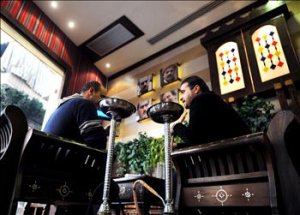Going Out in Dahiya

While conducting fieldwork for their doctoral dissertations in the late 1990s, Lara Deeb and Mona Harb found few places in the southern suburbs of Beirut where they felt comfortable working, resting, or sipping a cup of coffee. The internet cafés they encountered catered primarily to young men playing computer games, while the plastic chairs that were placed outside of storefronts, and that served as makeshift coffee shops, were the province of older men playing backgammon. Both types of places were equally gender exclusive. Less than ten years later, things had completely changed. Over one hundred new cafés and restaurants had opened, and they were home to a young, fashionable and mixed-gender clientele.
In Leisurely Islam, Deeb and Harb, an anthropologist and a political scientist, tell the story of this rapid transformation and shed light on the effects it has had on the social mores and spatial imaginary of Dahiya’s youths. Their book tackles three questions: Why did a vibrant café and restaurant culture suddenly emerge in an area of Beirut that was never known before as a hub of leisure? What kind of moral dilemmas do young people face while spending time in these new spaces of leisure, and how does this experience affect their moral outlooks? And finally, how does the emergence of new spaces and possibilities for leisure transform their experience of the city as a whole?
Leisurely Islam traces the emergence of a new leisure scene in Dahiya to two long-term developments and several precipitating circumstances. The two developments are the growth of a Shi‘i middle-class with the financial means to consume leisure, and the transformation of religiosity in Dahiya from a militant form of Islam into a more routinized social norm.
According to Deeb and Harb, Shi‘i social and economic mobility in Lebanon first took off in the late 1960s, as a result of Shehabist policies that strengthened public education and the provision of social services. With the advent of the civil war, the Shi‘i community also benefited from the rising clout of its two main political parties, Amal and Hizbullah. Amal initiated a steady redistribution of services and jobs to its constituency by establishing patronage networks in public agencies and partnerships with private entrepreneurs, while Hizbullah set up its own network of social organizations. These efforts, along with the work of social institutions affiliated with Grand Ayatollah Sayyid Muhammad Hussein Fadlallah, contributed to improving living standards within the Shi‘i community, and aided the development of a Shi‘i middle class. This process was further facilitated by a growing volume of remittances and investment from the Shi‘i diaspora in Africa, the Gulf, and the United States.
The other long-term development that paved the way for the emergence of new spaces of leisure in Dahiya is more subtle, and involves a shift in how people live their religiosity. Today’s youths grew up in an environment where Hizbullah was already a powerful political party, and where religious practices, such as wearing the veil, had become taken-for-granted social norms. In this regard, their experience differs quite radically from that of their parents, who had to fight for the institutionalization of the Islamic Resistance, and for a renewed commitment to Islam in everyday life. While Dahiya’s youths are still very much concerned with living a pious life, this no longer means the same thing for them as it did for their parents.
In today’s Dahiya, religious practices are not the risky outward manifestation of a personal commitment, but a social norm, to whom everyone, truly pious or not, must pay lip service. Markers of piety are therefore no longer seen to reflect the state of one’s inner self. A hijab is no longer necessarily read as a sign of virtue; it could just as well be a fashion accessory. The gap between one’s appearance and the state of one’s soul plays both ways. If looking pious is no guarantee that one is in fact pious, then the converse is plausible: one may still be pious even if one does not look the part. This gives young people some flexibility to experiment with new types of behavior, and it forces them to rely more extensively on their own judgment to assess what behavior is acceptable and what not.
This flexibility is rendered possible, in part, by the existence of multiple sources of jurisprudential reference (marja’) within the Shi‘i community, whom the youths can play against each other. The greater stress on individual judgment also owes much to the legacy of Fadlallah, one of the main jurisprudents in Lebanon, whose rulings tended to favor individual moral deliberation informed by social norms over hard rules and strict prohibitions.
The two trends I have just described—the emergence of a middle class consumerist youth, and the greater flexibility with which they can go about living pious lives—go a long way towards explaining the demand for new sites of “moral leisure”, and the interest of investors and entrepreneurs in starting them. But these two trends were a long time in the making, and on their own, they cannot help us understand the specific timing at which this new leisure scene emerged. For that, we must turn to history, and to a combination of three major events—the Israeli withdrawal from southern Lebanon in 2000, the assassination of former prime minister Rafic Hariri in 2005, and the July 2006 war between Hizbullah and Israel.
For many Shi‘i Muslims and Hizbullah sympathizers, who bore the brunt of the Israeli occupation, and who spearheaded the resistance to it, the Israeli withdrawal in 2000 marked a moment when they could finally afford to “breathe again”. This collective sense of relief meant that having fun in public was no longer seen as frivolous or objectionable. The withdrawal also accelerated the return of Shi‘i expatriates to Lebanon, and their willingness to invest in new business ventures.
If 2000 marks the moment at which the leisure scene in Dahiya started to develop, it is the political turmoil that followed the assassination of Hariri and the 2006 war with Israel that triggered its rapid expansion. The formation of two rival political camps, under the banners of March 14th and March 8th, and the trading of mutual accusations between them, contributed to inflaming tensions between Sunnis and Shi‘is. The climate of fear and inter-sectarian mistrust that resulted prompted a retrenchment within sectarian enclaves, and fueled the demand for leisure spaces closer to home. As a young man from Dahiya put it, echoing a widespread feeling in the form of a joke: “When we go to Beirut, especially after the July war, we tell our parents and our friends, in case something happens [laughing]! In Beirut, I am the Shi‘a who killed Rafic Hariri!”
It is important to note that the fieldwork for Leisurely Islam was conducted between 2007 and 2009, before Hizbullah’s involvement in the Syrian conflict, and the explosion of retaliatory car bombs in Dahiya. One cannot help but wonder, of course, how the sense of retrenchment has evolved since, and what has happened to Dahiya’s leisure scene in light of the drastic security measures that were put in place throughout the southern suburbs—but that is material for another book.
In addition to explaining why a new leisure scene emerged in Dahiya, the authors of Leisurely Islam advance two major claims. The first is that the growth of sites of leisure forces Dahiya’s pious youths to contend poignantly with a new breed of moral questions, as they decide where to go out, and how to behave in such venues. In selecting a café or restaurant, for instance, they must assess the reputation of the place, and whether the behavior of other clients is “morally appropriate” or not. Settling this question calls for a judgment that encompasses three separate rubrics—religious, social, and political-sectarian. The religious rubric involves ideas of piety and religious commitment or iltizam; the social rubric revolves around conceptions of social obligation, proprietary, and manners that are shared across Lebanese society; the political-sectarian rubric centers on allegiance to the Resistance, and to the political alliance led by Hizbullah.
In the new leisure spaces, these rubrics often come into conflict with one another. Should one accept an invitation to a wedding party at a restaurant (a social obligation) if one knows that the evening is likely to involve loud music and dancing (a religious prohibition)? Should one leave one’s friends prematurely (‘ayb) if one of the neighboring customers at a café decides to order alcohol (haram)? The new landscape of “moral leisure” places Dahiya’s youths in conditions where some measure of compromise is unavoidable. Deeb and Harb hazard to guess, perhaps somewhat too boldly, that this may eventually lead to greater openness in moral outlooks.
The second claim at the heart of Leisurely Islam is that the search for morally acceptable sites of leisure colors young people’s approach to urban space, and re-defines their maps of the city. Some neighborhoods unravel a vast array of possibilities, and come to be known intimately, while others are less inviting, and recede in the background. How this plays out in practice varies a great deal from one person to another. One young man virtually erases two of Beirut’s most bustling neighborhoods: “Outside of Dahiya, I mostly go to House of Donuts in Sodeco [now closed] and Tayyouneh. In Raouche, in Hamra, we go to Barbar, there’s nothing else there.” For twenty-year-old Zaynab, however, Beirut offers a much-coveted sense of liberation: “Outside is free, I feel free to laugh out loud without attracting attention in Beirut, whereas in Dahiya, people will notice and stare. […] I need to pay more attention to the way I dress, to my behavior.”
At an analytic level, neither of the two overarching claims that serve to structure the book is particularly new or surprising. Moral philosophers and sociologists of morality have long taught us that moral choices involve more than the application of rules, and that they require us to weigh various types of normative claims or spheres against each other. In the course of making these difficult judgments, and in justifying them to others, our preferences can become clearer, and our values can evolve and change. It is also common knowledge amongst geographers that people with different proclivities, occupations, and identities experience the city very differently, and that their mental maps vary considerably. These claims are well-rehearsed, and it is not surprising that they would hold in Dahiya, as they would anywhere else.
The richness of Leisurely Islam lies elsewhere: it is not so much in the theoretical claims that the authors make, but in the specificity and texture of the material with which they back them up. By carefully combining ethnographic observation and in-depth interviews, Deeb and Harb succeed in unpacking layers of meaning behind the seemingly mundane. They capture the complexity and nuances of everyday moral choices. They give us a taste, at times guttural, for what it is that makes the young men and women of Dahiya feel uncomfortable, for how they experience and resolve moral ambiguity, and for how they cope with the unavoidability of compromise. They describe with gripping detail how these youths, or at least a subset of them, experience space—which parts of the city they find inviting and which not, when they feel self-aware and why, and how they imagine that others see them when they cross the boundaries of Dahiya.
Deeb and Harb are equally perceptive when it comes to describing the spatial environment in which their story unfolds. In one section of the book, they turn their attention to the interior decoration of Dahiya’s cafés, and identify four dominant aesthetics: a “heritage” style emphasizing themes of village life, expressed architecturally though stone-like walls, wood, and wrought iron; a “nature-garden” style which interrupts the dense urban environment with greenery and water canals, or more modestly, with artificial flower arrangements and photographs of snow-capped mountains; a “formal dining” style with heavy wooden tables, multi-layered curtains, fancy chandeliers, and patterned fabrics; and a “contemporary” style, with furniture in “leather, glass, steel, and sometimes plastic”, bright colors, English only-menus, and walls “striped or covered in photographs that resemble stylized advertising copy.”
These various styles are often mixed and matched within the same establishment. Deeb and Harb argue that such eclecticism, which is often dismissed as a sign of poor taste, is in fact the result of a series of strategic decisions by establishment owners, who try to hedge their bets by providing something that would appeal to various clienteles, and who are keen on segmenting space into different zones into which they could direct similar kinds of customers (students looking to work, couples on a date, families, etc.).
Given the richness of the material they present, it is rather unfortunate that Deeb and Hard do not devote as much attention to their methodology as they do to their subject matter. We are told that the book relies on a survey of over 400 customers across six cafés in Dahiya, but we do not learn how the customers where approached, nor how the study was described to them. We are not sufficiently introduced, either, to the research assistants who conducted the surveys, and we do not get a sense how they would have been likely to be perceived by the customers.
This lack of methodological transparency or reflexivity is surprising coming from scholars who otherwise show a great deal of ethnographic sensitivity, and it unfortunately extends to the semi-structured group interviews which form the backbone of the book. We are told that such interviews were conducted with a total of 52-youths, in combinations of two to four. But we are left in the dark as to how the participants were recruited, and how they were paired up with each other. Deeb and Harb write that they opted for group interviews to get a sense of how people talk about leisure in front of others. This is a sensible choice, but of course, what people say does not only depend on the interviewees who surround them, but also on the context in which they are interviewed, and on the researcher they have in front of them. It would have been helpful, as such, to know where the interviews took place, what topics were brought up by the researchers, and in what order. It would have been even more important, perhaps, to hear the authors reflect at greater length as to how their own social class, institutional affiliation and status as university professors may have affected the nature of what was said, and the extent to which this could account for the moral openness they saw on display.
Leisurely Islam also suffers from the absence of a sustained comparative framework to anchor the analysis. To get a good grasp of what it’s like to be a pious youth in Dahiya’s cafés, one needs something to distinguish that experience from, and to compare it to. Deeb and Harb, however, do not say much about what leisure looked like for Dahiya’s youths before the advent of cafés. And while they interview young people at length about how they behave when they are not in Dahiya, they do not actually observe them roaming around the city. The authors justify their reliance on interviews by saying that they are primarily interested in capturing what people say they do rather than what they in fact do. But their analysis is far more illuminating when they combine interviews with ethnographic observation, as they do within the space of Dahiya’s cafés, with an ear for those moments when the talking and the doing come apart.
If the goal of the book is to trace how pious youths relate to spaces of leisure and to the city that surrounds them, then one could legitimately ask why Deeb and Harb did not follow them more consistently on their daily trajectories beyond the boundaries of Dahiya. One may also wonder why Dahiya’s not-so-pious youths and their leisure spaces figure so little in Deeb and Harb’s story. This absence is conspicuous in a book on Dahiya’s leisure scene, especially given the ongoing proliferation of liquor stores and gambling centers that allegedly cater to Dahiya’s residents in adjacent Christian neighborhoods such as Ain-El-Remmaneh.
The point is not simply to state the obvious, namely, that the book would have been stronger if Deeb and Harb had done more—by exploring what leisure looked like before the advent of cafés, by observing how pious youths behave outside of Dahiya, and by showing how their experience differs from that of non-pious youths. The point, rather, is that doing such things would have helped bring the phenomenon they are interested in—the experience of pious youths in Dahiya’s cafés—into sharper focus, by giving us something to compare it to, and to contrast it with.
For all these reservations, Leisurely Islam is a captivating read. Deeb and Harb tell a fascinating tale about the development of a certain form of consumerism, and how its expression is modulated by the social, political and religious commitments that pre-existed it. In doing so, they redirect our attention away from the sensationalistic events that are often associated with Dahiya—those that revolve around the familiar themes of resistance, mobilization, violence, party politics, etc.—and towards the ethics of everyday life. Their analysis illustrates how important it is to place individual moral judgment at the center of our accounts of social behavior, without covering up the wide differences that exist amongst individuals as to how they exert such judgment. The picture that emerges—complex, ambiguous, and traversed by unresolved tensions—stands as a cogent reminder, if one was needed, that for all the talk of exceptionalism that goes around about Dahiya, Beirut’s southern suburbs and their residents are very much of the city and of the world.



